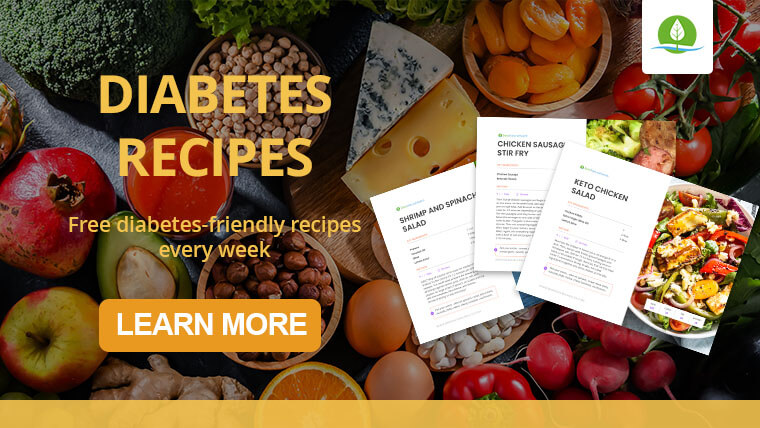Hyperglycemia (high blood sugar) is an increasingly-prevalent problem today.
If you’ve been diagnosed with hyperglycemia, you might wonder if there is a hyperglycemia diet to help you bring your blood sugar levels back into a healthier range.
Keep reading to learn five foods to eat and five foods and drinks you may want to limit or avoid.
What is hyperglycemia?
Hyperglycemia is the medical term for high blood glucose levels. Blood glucose (blood sugar) is measured using milligrams per deciliter (mg/dL).
A normal blood glucose level (no diabetes) when you’ve been fasting for 8-12 hours is below 100 mg/dL and less than 140 mg/dL two hours after eating a meal.
High blood sugar can be diagnosed with different blood tests, including fasting blood sugar, random blood sugar, hemoglobin A1c, or a glucose tolerance test. A glucose tolerance test is how gestational diabetes (diabetes during pregnancy) is diagnosed.
Hyperglycemia is often associated with health conditions like diabetes and insulin resistance. Insulin is produced by cells in your pancreas and helps lower blood sugar levels.
Insulin resistance is when your body doesn’t use the hormone insulin as it should. It is the main cause of type 2 diabetes.
If you have diabetes and your blood sugar levels increase to a dangerously high level, a serious condition called diabetic ketoacidosis can occur. Diabetic ketoacidosis typically impacts people with type 1 diabetes and requires prompt medical attention.
Diabetic ketoacidosis occurs when insulin levels fall so low that fat starts burning as fuel since blood glucose can’t enter the body’s cells.
Hyperglycemia can also be short-lived in the case of illness, medical stress, such as undergoing surgery and taking certain medications. These cases don’t usually require any lifestyle modifications.
Get Your FREE Diabetes Diet Plan
- 15 foods to naturally lower blood sugar levels
- 3 day sample meal plan
- Designed exclusively by our nutritionist
Can you manage hyperglycemia with dietary changes?
Many people with diabetes take diabetes medication to help control their blood glucose levels. You can also manage hyperglycemia through lifestyle changes, including dietary changes. Some people can manage their blood sugar through diet alone, while others need a combination of medication and lifestyle changes.
While there isn’t a universal hyperglycemia diet, there are ways to promote healthy blood glucose levels through your diet.
The nutrient that gets the most attention in blood sugar is carbohydrates. Carbohydrates (carbs) are one of the three main nutrients your body needs to provide it with energy.
Carbs are in foods like fruits, vegetables, grains, legumes, milk, yogurt, and any food with added sugar like sweets and desserts.
Carbs are broken down into glucose during digestion. The more carbs you eat, the higher your blood glucose level will be after that meal.
Carbs aren’t bad and you don’t necessarily need to avoid them on a hyperglycemia diet. The more important thing is to focus on healthy carbs and be mindful of your portion sizes.
5 foods to eat
1. Whole grains
Grains are a type of carb, but they fall under the “healthy carb” category. Whole grains are rich in fiber, a type of carb that doesn’t raise your blood sugar level. The higher the fiber content, the less impact the food will have on your blood glucose.
A few examples of whole grains are oatmeal, brown rice, whole wheat bread, bulgur, barley, and whole-wheat pasta. Whole grains are also richer in protein than refined grains like white rice and white bread.
2. Non-starchy vegetables
Most vegetables are low in carbs and rich in fiber, so they don’t raise blood glucose levels significantly. Vegetables are also a great source of vitamins and minerals.
A hyperglycemia diet should include plenty of non-starchy vegetables such as:
- Artichoke
- Asparagus
- Beans (green, wax, Italian)
- Beets
- Brussels sprouts
- Broccoli
- Cabbage (green, bok choy, Chinese)
- Cauliflower
- Eggplant
- Green leafy vegetables (collard, kale, mustard, turnip)
- Jicama
- Kohlrabi
- Leeks
- Mushrooms
- Onions
- Peapods
- Peppers
- Radishes
- Rutabaga
- Salad greens (chicory, endive, escarole, lettuce, romaine, spinach, arugula, radicchio, watercress)
- Sprouts
- Squash (cushaw, summer, crookneck, spaghetti, zucchini)
- Sugar snap peas
- Swiss chard
- Tomatoes
- Turnips
3. Nuts
Nuts are composed mainly of healthy unsaturated fats as well as protein. Fat and protein don’t raise blood sugar like carbs. You should include protein with all meals and snacks on a hyperglycemia diet.
Eating protein and fat with carbohydrates can help slow the rise in blood glucose after eating. For example, eating a handful of nuts along with some fresh fruit will likely raise blood sugar less than eating fruit alone.
4. Protein rich foods (meat, chicken, eggs, & fish)
Animal products are rich in protein and free of carbs. According to the Plate Method for Diabetes, one-quarter of your plate should consist of protein at meals, and the same is true for a hyperglycemia diet. Protein has minimal impacts on blood glucose levels and can help boost satiety after meals.
5. Legumes
Legumes like beans and lentils are a great plant-based source of protein. They also contain a lot of fiber and beneficial nutrients like iron, magnesium, and folate.
Legumes are a type of starchy vegetable, so they contain more carbs than nonstarchy vegetables.
If you were to eat a large portion of legumes, you could still experience hyperglycemia. Balancing legumes with non-starchy vegetables and protein can help prevent a spike in blood glucose.

5 foods and drinks you should avoid
1. Sugary treats, candy, etc
Foods high in added sugar can cause blood glucose spikes so you should eat them sparingly on a hyperglycemia diet.
Sweetened foods like candy, ice cream, cake, etc., are usually sweetened with sucrose (table sugar), corn syrup, or high-fructose corn syrup. These sweeteners are broken down into blood glucose very quickly and can worsen glycemic control.
2. Refined grains
Refined grains are stripped of their nutrient and fiber-rich parts, leaving behind a lower-fiber, lower-nutrient grain. These grains are often enriched with the vitamins and minerals that were lost during the refining process, which is why many refined grains have the ingredient “enriched flour” as the main ingredient.
White bagels, flour tortillas, white bread, and white rice are just a few examples of refined grains that you should avoid on a hyperglycemia diet.
3. Other foods with added sugar
Added sugar isn’t always easy to spot. Sugar is added to foods that might otherwise seem healthy, like yogurt, certain nutrition bars, and granola.
Check the nutrition facts label and try to avoid foods with more than five grams of added sugar per serving. Aim to keep your added sugar intake below 30 grams per day on a hyperglycemia diet.
4. Sugary drinks
Sugary drinks are the leading contributor of added sugar in a typical Western diet. Drinks like soda, sweetened teas, sugary coffee drinks, energy drinks, and many more contain lots of sugar.
Liquids empty from your stomach very quickly, which means that this sugar is readily available to turn into blood sugar and leads to hyperglycemia.
5. Fruit juice
100% fruit juice is a better option than sugary drinks like soda. However, fruit juice is high in sugar and low in fiber compared to whole fruit. Aim to eat whole fruit instead of fruit juice on a hyperglycemia diet.
For example, one cup of orange juice contains 21 grams of sugar and less than one gram of fiber. One whole medium orange contains 12 grams of sugar and three grams of fiber.
Conclusion
A hyperglycemia diet is rich in fiber and nutrient-rich foods like non-starchy vegetables, legumes, nuts, and high-quality protein.
A hyperglycemia diet avoids refined carbohydrates, foods high in added sugars, and sugary drinks.
Explore More







